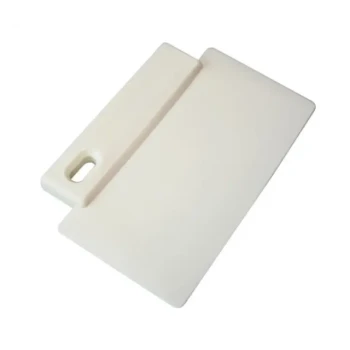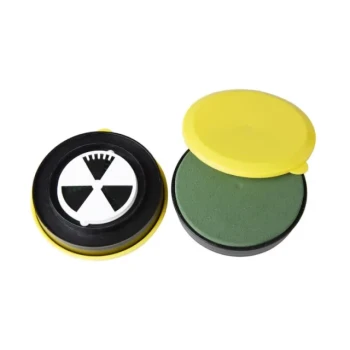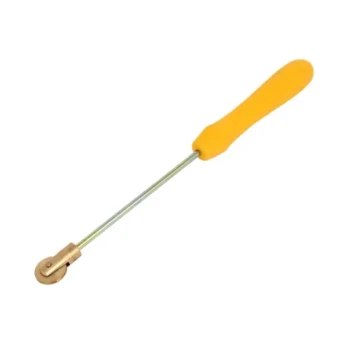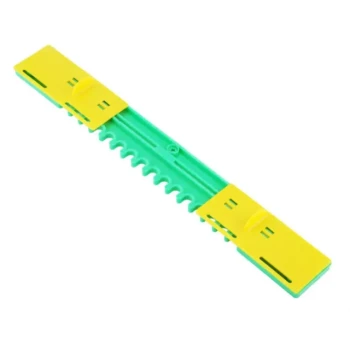A single pollen grain has a diameter ranging from approximately 5 to 200 micrometers (µm). To put this into perspective, the smallest pollen grains are more than ten times smaller than the width of a typical human hair, while the largest can be more than twice as wide.
The vast range in pollen size is not random; it is a direct consequence of a plant's reproductive strategy. This size variation is the primary factor determining how pollen travels, its potential to cause allergies, and how effectively it can be filtered from the air.

Visualizing the Scale
Understanding the size of pollen requires a comparison to familiar objects. The micrometer (also called a micron) is the standard unit of measurement, equal to one-millionth of a meter.
A Human Hair as a Reference Point
A typical human hair is about 70 micrometers in diameter. This means the most common allergenic pollens, like those from ragweed (around 20 µm), are less than a third of the width of a single hair.
The Limits of Human Vision
The naked human eye can, under ideal conditions, see objects as small as 40 micrometers. This explains why we cannot see individual grains of allergenic pollen floating in the air, but we can see the yellow dust that collects on surfaces, which is a large accumulation of many grains.
Why Such a Wide Range? The Link to Pollination Strategy
The size of a pollen grain is intrinsically linked to how a plant ensures its reproduction. The method of dispersal is the key determinant.
Small Pollen for Wind Dispersal (Anemophily)
Plants that rely on wind to carry their pollen—such as grasses, ragweed, and many trees like pine and oak—produce vast quantities of small, lightweight, and aerodynamic grains. These grains, typically in the 5 to 40 micrometer range, are designed to travel long distances with minimal effort.
This strategy is effective for reproduction but is also the reason these plants are the primary source of seasonal allergies.
Large Pollen for Animal Dispersal (Zoophily)
Plants with showy, colorful flowers typically rely on insects, birds, or other animals to transfer their pollen. This pollen is often larger, heavier, and stickier, designed to adhere to a pollinator's body.
These grains, which can be 50 to 200 micrometers or even larger, are not designed for long-distance air travel. Because they don't become airborne in significant quantities, they rarely cause allergic reactions.
Understanding the Trade-offs: Size and Its Consequences
The physical size of a pollen grain has direct consequences for human health and environmental engineering.
The Allergenic Potential
It is the small, wind-borne pollen that is easily inhaled deep into the respiratory system, triggering an immune response in sensitive individuals. Grains smaller than 25 micrometers are the most problematic.
Filtration Challenges
The wide range of pollen sizes presents a challenge for air filtration. A filter must have pores fine enough to capture the smallest allergenic grains.
This is why HEPA (High-Efficiency Particulate Air) filters are the standard for allergy sufferers. By definition, they must capture at least 99.97% of particles that are 0.3 micrometers in size—far smaller than any pollen grain.
Durability and Scientific Value
The tough outer shell of a pollen grain, called the exine, is incredibly durable. This durability, combined with unique sizing and shaping for each species, allows pollen to be preserved in sediment for thousands of years. Scientists (palynologists) analyze this fossilized pollen to reconstruct ancient climates and ecosystems.
Making the Right Choice for Your Goal
Your reason for asking about pollen size dictates which part of the range is most important to you.
- If your primary focus is managing allergies: Understand that the smallest, invisible pollen grains (typically under 40 µm) from wind-pollinated plants are the main cause of your symptoms.
- If your primary focus is air filtration: Select filters, like HEPA, that are certified to capture particles significantly smaller than 5 µm to effectively remove the most pervasive airborne allergens.
- If your primary focus is gardening or botany: Recognize that the larger, often visible pollen from vibrant flowers is designed for pollinators and is highly unlikely to be an airborne irritant.
Understanding this microscopic scale gives you the knowledge to better control your environment and its effect on your well-being.
Summary Table:
| Pollen Size Range (µm) | Primary Dispersal Method | Key Characteristics & Examples |
|---|---|---|
| 5 - 40 µm | Wind (Anemophily) | Small, lightweight, airborne; primary cause of allergies (e.g., Ragweed, Grasses, Pine). |
| 50 - 200+ µm | Animal (Zoophily) | Larger, heavier, sticky; carried by pollinators (e.g., flowering plants); rarely allergenic. |
Equip your apiary for success with HONESTBEE. Understanding pollen is key to healthy bees and optimal honey production. As a trusted wholesale supplier for commercial apiaries and distributors, we provide the durable, high-performance beekeeping supplies and equipment you need to support your pollinators effectively. Contact our expert team today to discuss your wholesale needs and discover the HONESTBEE difference.
Visual Guide
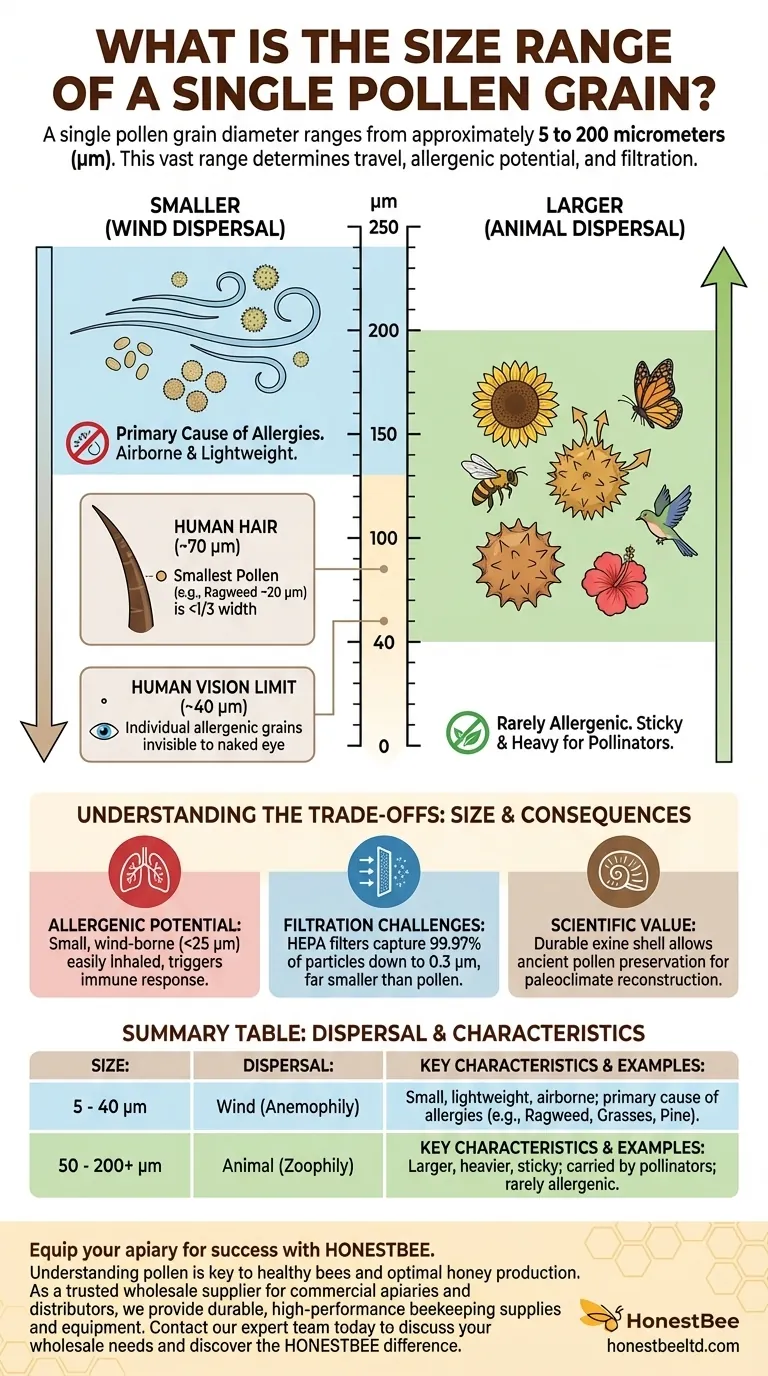
Related Products
- Beehive Handle and Frame Rest Cutting Machine: Your Specialized Hive Machine
- Professional Wide Blade Honey Scraper for Beekeeping and Honey Processing
- Plastic Chinese Queen Grafting Tool for Bee Queen Rearing
- Professional Galvanized Hive Strap with Secure Locking Buckle for Beekeeping
- Yellow Plastic Bucket Pail Perch for Beekeeping
People Also Ask
- How does the Flow Hive work? A Look at the Revolutionary 'Honey on Tap' System
- What are the benefits of using a Flow Hive for honey extraction? A Gentler, Simpler Harvest for Hobbyists
- What does every bee keeper need? Your Essential Guide to Starting Strong
- What parts of bee equipment should be painted? A Guide to Protecting Your Hive and Your Bees
- What are the additional functions of a modified hive tool? Boost Precision & Efficiency in Your Apiary

